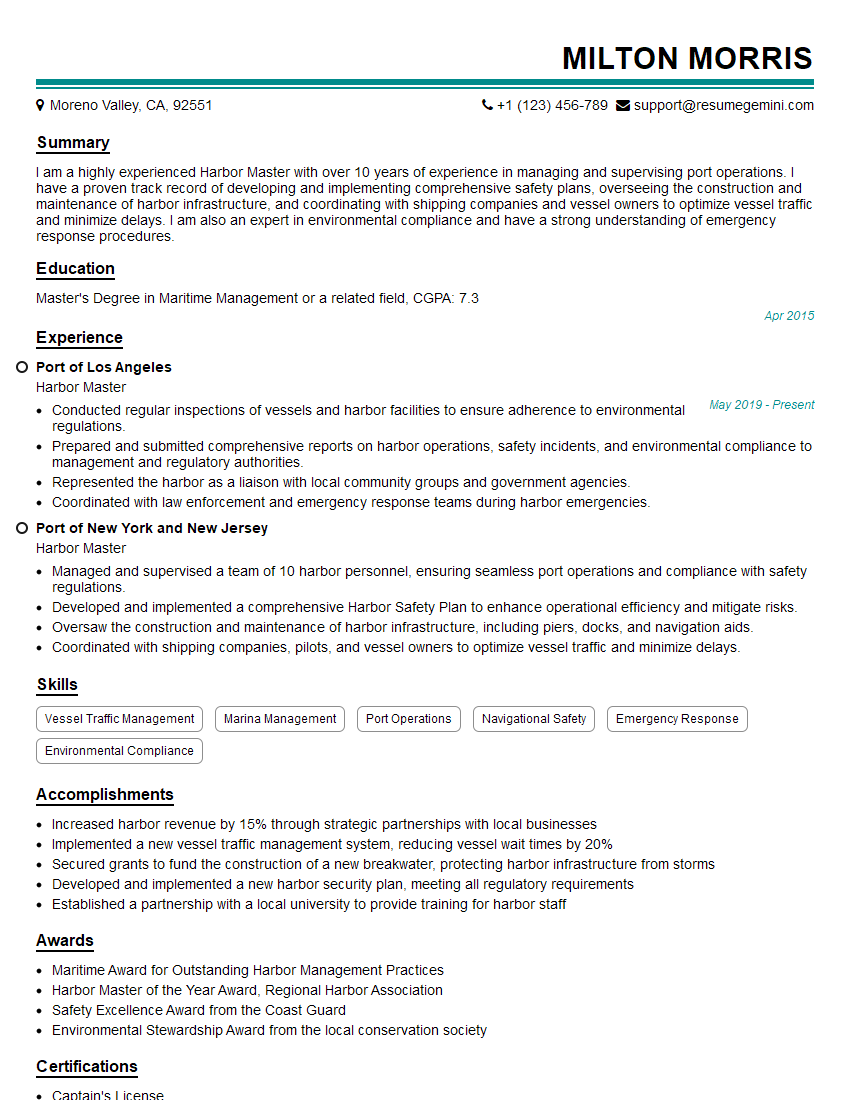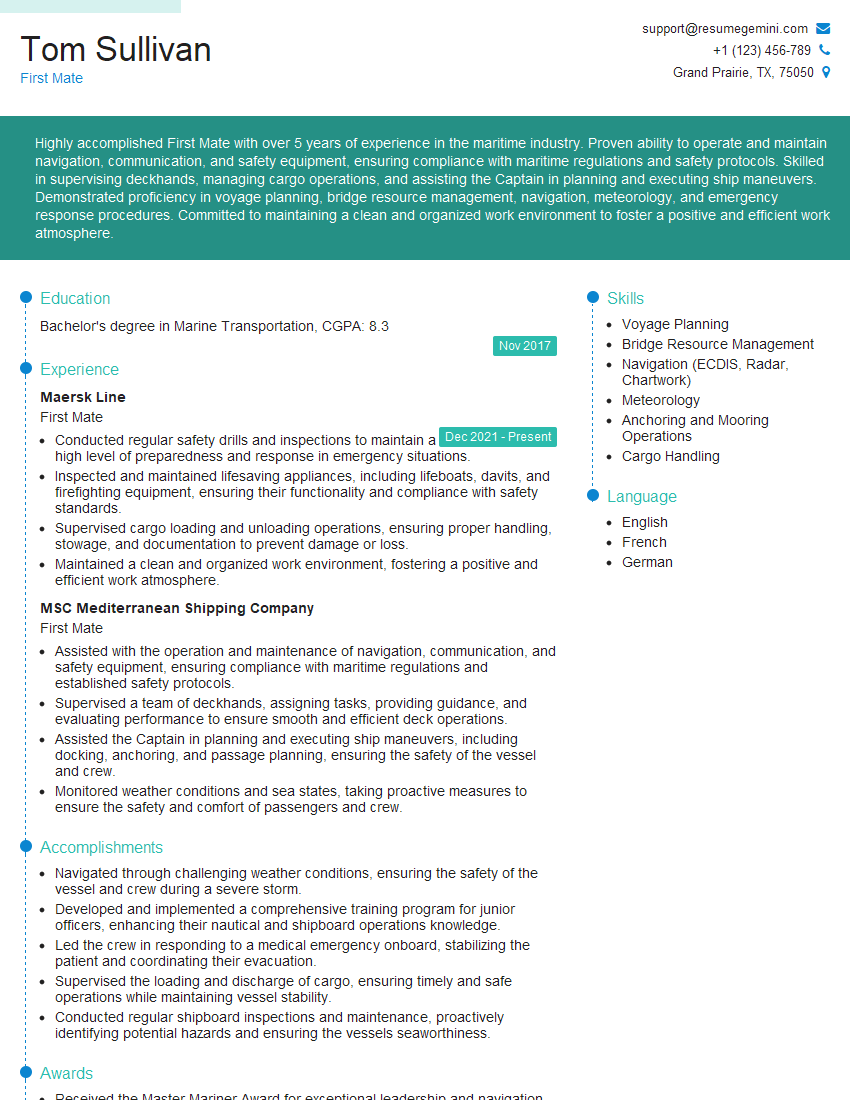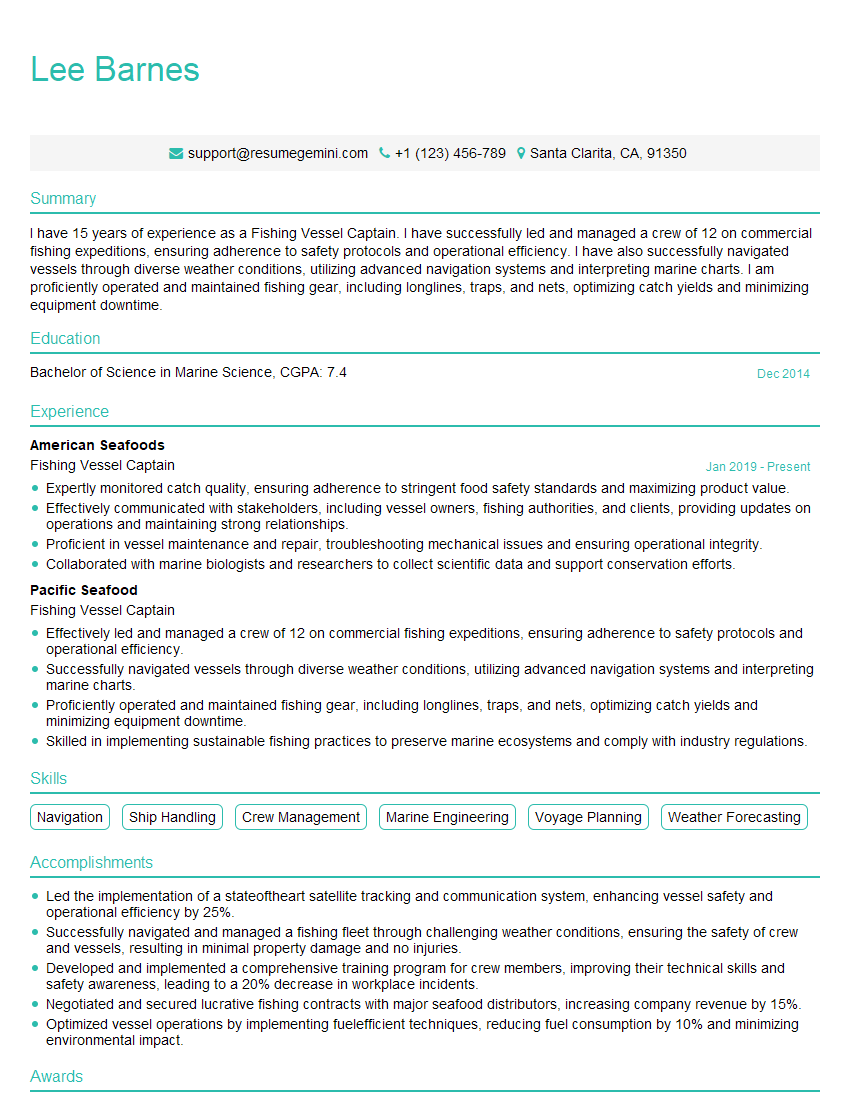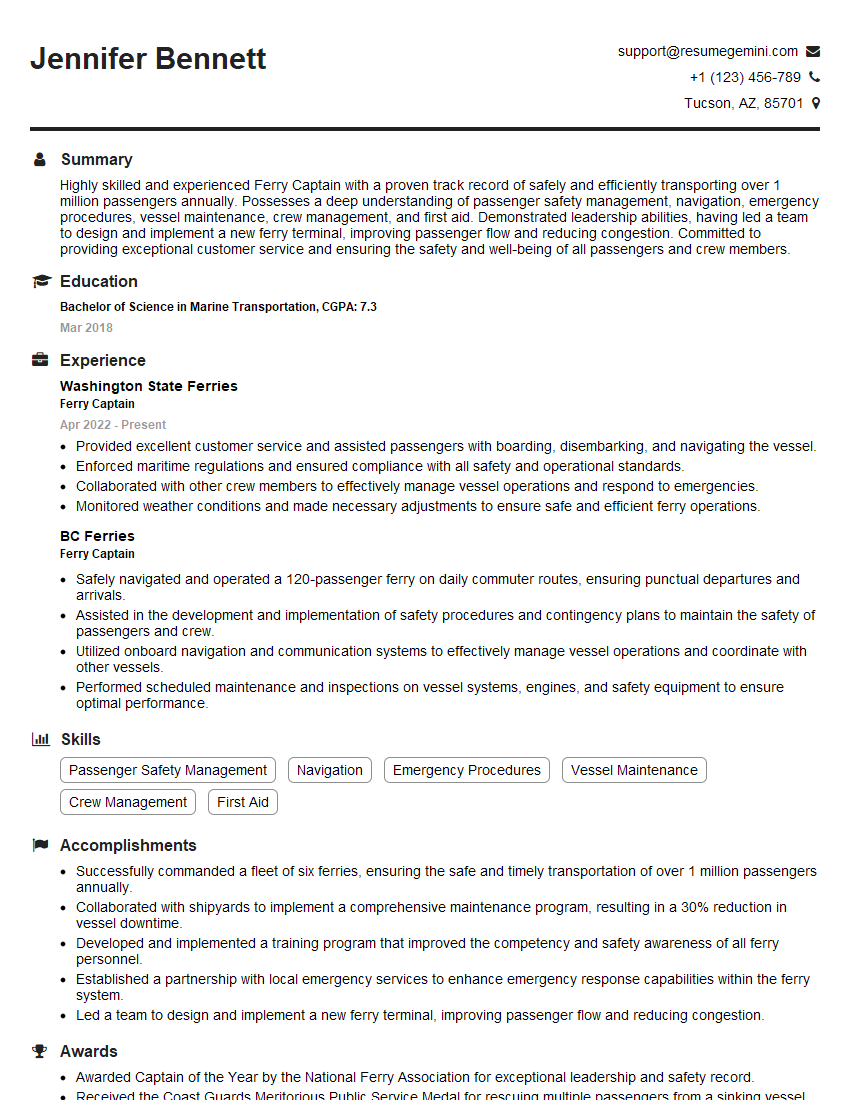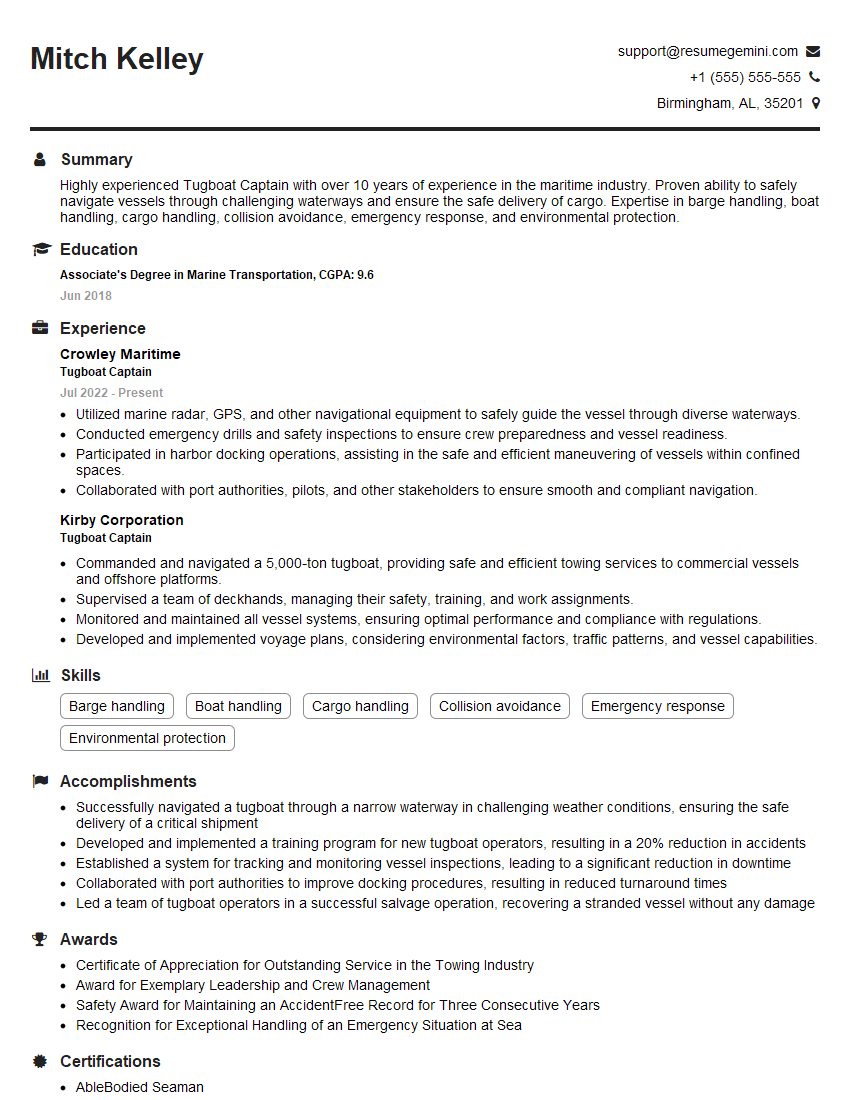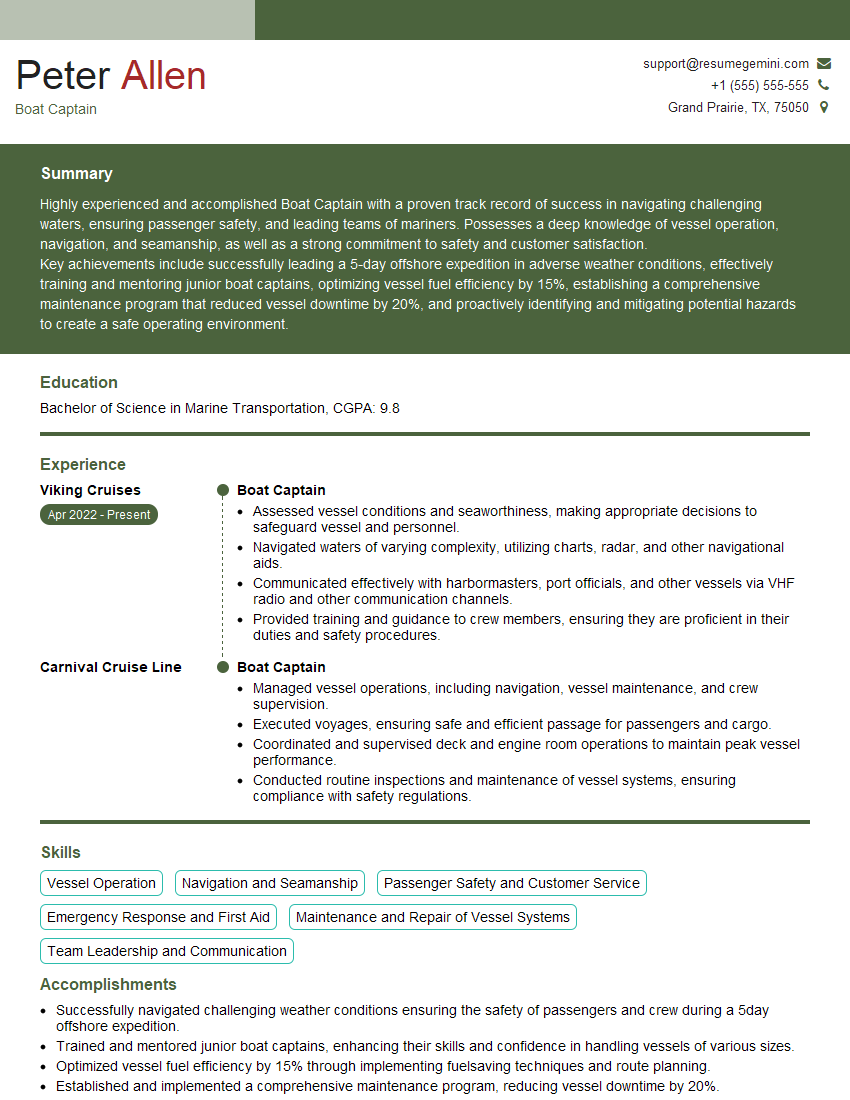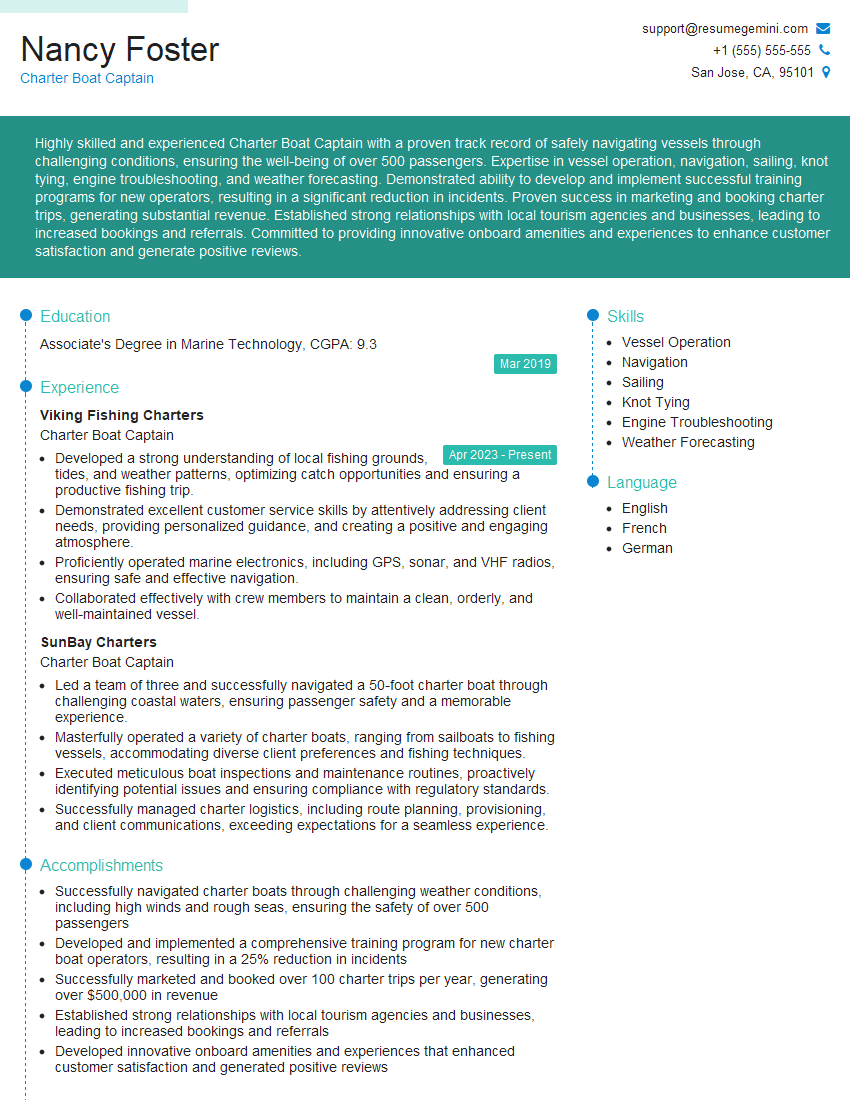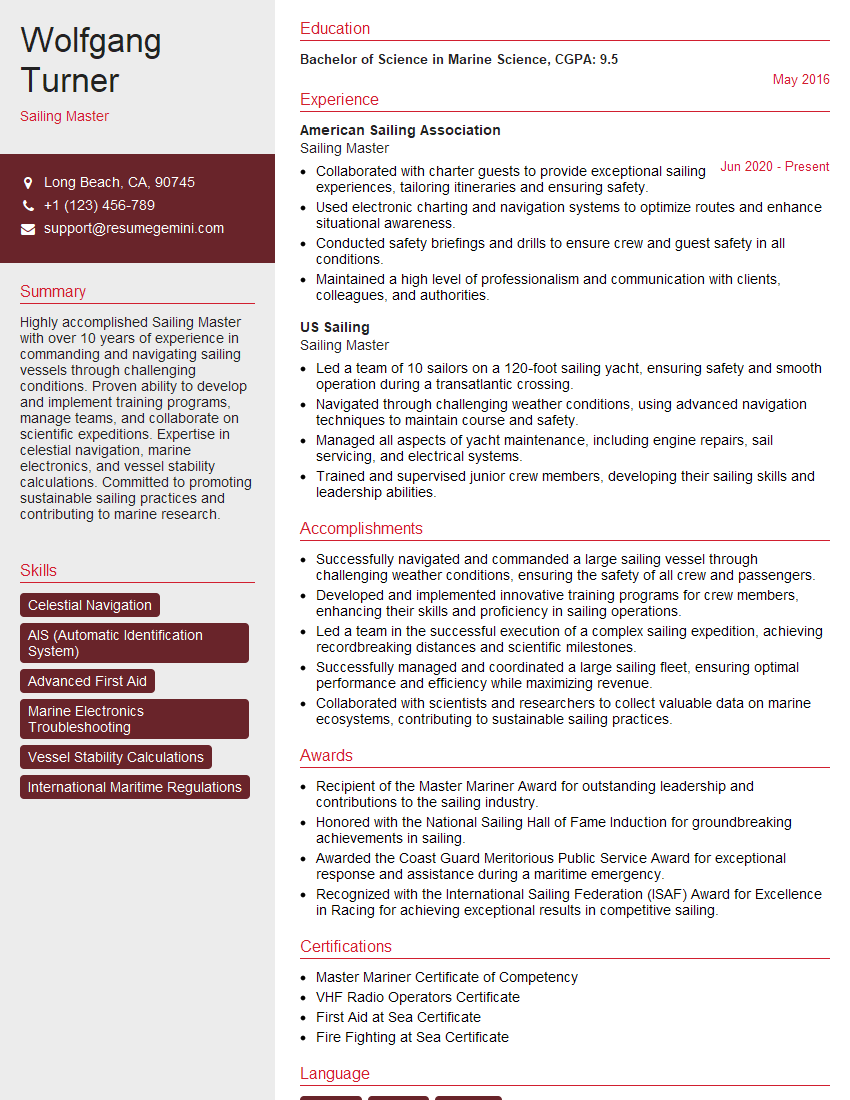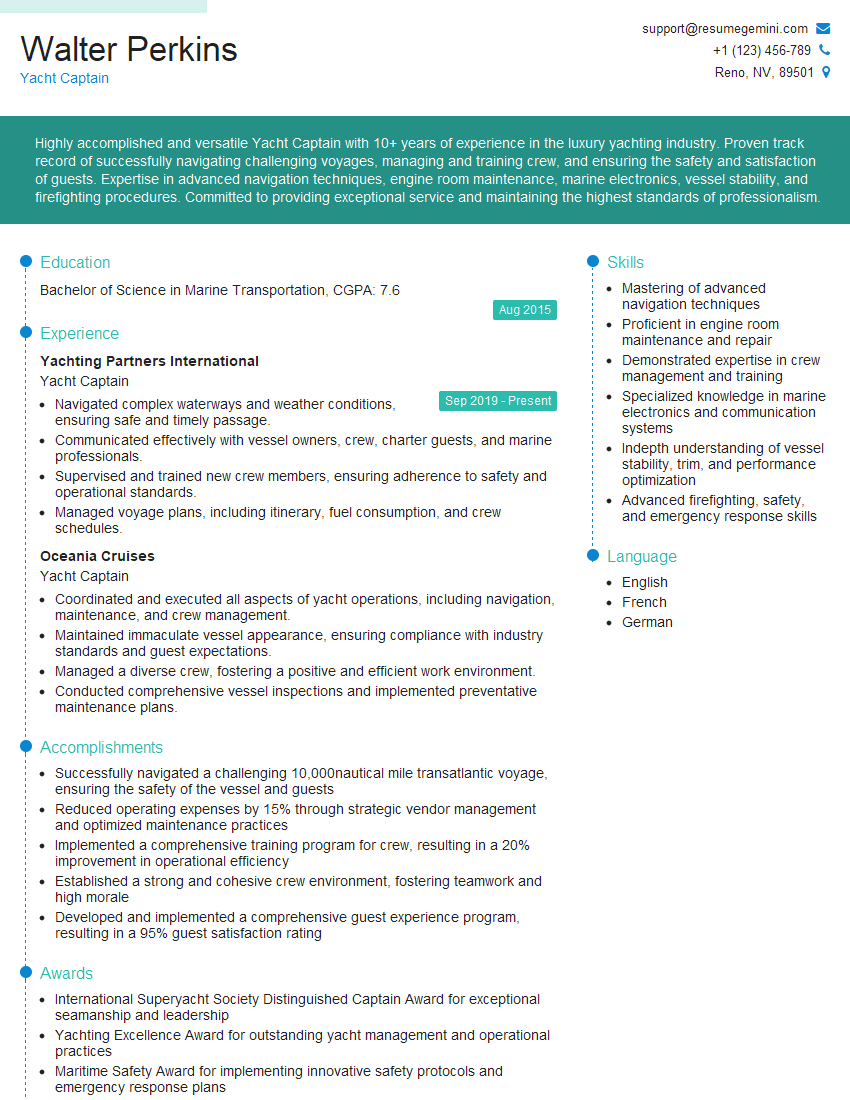Are you ready to stand out in your next interview? Understanding and preparing for Small Craft Navigation interview questions is a game-changer. In this blog, we’ve compiled key questions and expert advice to help you showcase your skills with confidence and precision. Let’s get started on your journey to acing the interview.
Questions Asked in Small Craft Navigation Interview
Q 1. Explain the process of taking a celestial fix.
Taking a celestial fix involves determining your position by measuring the altitude of celestial bodies (like the sun, moon, or stars) and comparing it to their calculated altitudes at a specific time. This provides a line of position (LOP), and by taking multiple sights of different bodies, you can pinpoint your location where the LOPs intersect.
The process involves these steps:
- Identify the celestial body: Using a nautical almanac or similar tool, identify the celestial body you’ll observe.
- Measure the altitude: Use a sextant to accurately measure the altitude of the body above the horizon. This measurement needs to be corrected for various factors like index error, dip of the horizon, and refraction.
- Note the time: Record the precise Greenwich Mean Time (GMT) of the observation. Accuracy here is crucial.
- Calculate the LOP: Using the nautical almanac or a sight reduction computer, calculate the LOP based on the observed altitude, the GMT, and the body’s declination and Greenwich Hour Angle (GHA).
- Plot the LOP: Draw the LOP on a chart. This is usually a line, representing all possible positions consistent with the observation.
- Take multiple sights: Repeat steps 1-5 for at least two different celestial bodies (ideally three for redundancy) to obtain multiple LOPs. The intersection of these LOPs gives your fix.
Example: Imagine you take a sight of the sun and obtain a LOP. Then, you take another sight of Polaris (the North Star) and get another LOP. The point where these lines cross on your chart is your approximate position.
Q 2. Describe the different types of compasses used in small craft navigation.
Small craft navigation uses several compass types, each with strengths and weaknesses:
- Magnetic Compass: The most basic type, relying on the Earth’s magnetic field to indicate magnetic north. It’s relatively simple, inexpensive, and requires no power. However, it’s susceptible to magnetic deviation (caused by onboard metal) and magnetic variation (the difference between magnetic north and true north).
- Gyrocompass: This type uses a spinning gyroscope to maintain a fixed orientation relative to the Earth’s rotation, indicating true north. It’s more accurate than a magnetic compass, unaffected by magnetic fields, but it’s more complex, expensive, and requires a power source.
- Fluxgate Compass: An electronic compass that uses magnetic sensors to determine magnetic heading. They are generally more accurate than a magnetic compass and less prone to deviation than traditional magnetic compasses, though still subject to variation.
- GPS Compass: GPS receivers often include a compass function, deriving heading from the GPS satellite signals. This is generally a very accurate compass, independent of magnetic fields but requires a clear view of the satellites and a working GPS receiver.
The choice depends on the vessel’s size, budget, and navigational requirements. Larger vessels often use gyrocompasses, while smaller craft might rely on magnetic or GPS compasses.
Q 3. How do you correct for magnetic variation and deviation?
Magnetic variation and deviation cause errors in magnetic compass readings. Correcting for them is crucial for accurate navigation.
- Magnetic Variation: The difference between magnetic north (indicated by the compass) and true north (geographic north). It varies by location and is shown on nautical charts. To correct, you add or subtract the variation as indicated on the chart – adding if magnetic north is east of true north (Easterly variation), subtracting if it’s west.
- Deviation: The error caused by magnetic interference from the vessel’s metal structures, equipment, and even the cargo. It varies depending on the compass’s heading. To correct, a deviation table or card is created by swinging the compass through 360 degrees. This shows the deviation for each heading. During navigation, the correction indicated for your current heading is applied. This requires careful calibration and frequent checks for changes in deviation over time.
Example: Let’s say your compass shows 090 degrees (magnetic), the variation is 15 degrees West, and the deviation at this heading is 3 degrees East. The calculation would be: 090 (magnetic) + 15 (variation West) – 3 (deviation East) = 102 degrees (true).
Q 4. What are the principles of piloting using GPS?
Piloting with GPS relies on receiving signals from GPS satellites to determine your precise position (latitude and longitude). The principles involve:
- Satellite Triangulation: The GPS receiver calculates its position by receiving signals from at least four GPS satellites. The time it takes for the signal to reach the receiver, combined with the satellite’s known position, allows the receiver to triangulate its position.
- Position Plotting: The receiver displays your position on a chart or screen, usually as a latitude/longitude coordinate or a point on an electronic chart.
- Course and Speed Calculation: Many GPS devices calculate your course over ground (COG) and speed over ground (SOG) which are crucial for navigation and dead reckoning.
- Waypoint Navigation: You can program waypoints (desired positions) into the GPS. The device then guides you along a course to reach those waypoints, indicating distance to go and bearing.
Practical Application: GPS is used for everything from coastal navigation to offshore passages, significantly improving safety and efficiency. However, it’s essential to understand that GPS is a supplemental tool and never a sole reliance, as signals can be temporarily or permanently interrupted due to atmospheric conditions or intentional jamming.
Q 5. Explain the concept of dead reckoning and its limitations.
Dead reckoning (DR) is estimating your position based on your last known position, course, speed, and time elapsed. It’s a fundamental navigation technique, even in the age of GPS.
Principles: You start with a known position, then use your course and speed to project your new position after a certain time. This projection is usually done on a chart or using a computer.
Limitations: DR is inherently inaccurate due to several factors:
- Currents and Wind: These affect your vessel’s actual position, causing drift from your calculated position.
- Errors in Course and Speed: Inaccurate compass readings or speed estimates significantly impact the accuracy of your DR position.
- Leeway: The sideways movement of the vessel due to wind can be difficult to estimate.
Example: If you know you’re at position A and sail at 10 knots on a heading of 090 degrees for two hours, you estimate your new position B based on a 20 nautical mile travel (10 knots x 2 hours).
Importance: Despite limitations, DR is a crucial tool, especially in case of GPS failure. It provides a running estimate of your position, aiding in cross-checking your actual position from other sources.
Q 6. How do you use electronic charts and plotting aids?
Electronic charts (EC) and electronic charting systems (ECS) have revolutionized navigation. They are digital representations of nautical charts, offering numerous advantages over paper charts.
Use:
- Chart Display: ECS displays the chart on a screen, allowing for zooming, panning, and overlaying various data layers.
- Position Plotting: Your vessel’s position is displayed on the chart in real time, usually via GPS input.
- Route Planning: ECS allows for planning routes, setting waypoints, and calculating distances and estimated times of arrival (ETAs).
- Alarm Functions: ECS can be set to alert the navigator of shallow water, obstructions, or other hazards.
- Tidal information: Tide and current information is often integrated into electronic charts, offering predictions.
Plotting Aids: ECS typically include plotting aids, such as range rings, bearing lines, and other tools for precise navigation.
Example: When approaching a harbor, the ECS can display shallow areas, buoys, and other navigation markers, simplifying safe navigation. It can also provide real-time water depth data, ensuring you avoid dangerous shoals.
Caution: Relying solely on ECS is risky, regular checks against paper charts are often mandated and best practice for safety.
Q 7. Describe the process of calculating tidal currents.
Calculating tidal currents involves understanding that they are the horizontal movement of water caused by the rise and fall of tides. The strength and direction of tidal currents vary with location, time, and tidal stage.
Methods:
- Tidal Charts and Tables: Nautical charts and tidal stream atlases provide information about the direction and speed of tidal currents at specific locations and times. They usually show the strength of the current (knots) in the form of arrows for each hour of the tidal cycle.
- Tidal Current Prediction Programs: Sophisticated software or apps can compute the predicted current velocity and direction at any given location and time, based on complex algorithms and harmonic constants.
- Local Knowledge: Experienced mariners often have a good understanding of the local tidal currents through experience.
Example: A tidal stream atlas might show that in a particular area, the current flows at 2 knots to the north at high water, and 1 knot to the south at low water. By understanding the time of high and low water, you can estimate the current’s strength and direction during your planned passage.
Importance: Tidal currents can significantly affect your vessel’s course and speed, especially in narrow channels or areas with strong currents. Accurate prediction of these currents is essential for safe and efficient navigation.
Q 8. Explain the significance of chart symbols and abbreviations.
Chart symbols and abbreviations are crucial for safe navigation. They represent various features, hazards, and navigational aids concisely on nautical charts. Understanding them is essential for accurate plotting and avoiding dangers. Think of them as a highly efficient shorthand language for mariners.
- Depths: Numbers indicate depths in meters or feet, often accompanied by symbols showing the type of seabed (e.g., sand, rock).
- Navigation Aids: Symbols clearly depict lighthouses (with characteristics), buoys (with their shape, color, and light characteristics), and beacons. For example, a red buoy with a flashing light has a specific meaning that a navigator must understand.
- Hazards: Wrecks, rocks, obstructions, and other dangers are shown with specific symbols, often accompanied by details such as depth and location. These symbols are crucial for route planning and collision avoidance.
- Landmarks: Buildings, trees, and other landmarks are represented to help with position fixing and orientation, especially in coastal waters.
For example, a small circle with a cross inside might indicate a wreck, while a triangle might represent a danger area. Knowing the meaning of these symbols is non-negotiable for safe navigation.
Q 9. How do you interpret weather forecasts relevant to small craft operations?
Interpreting weather forecasts for small craft is critical for safety. I focus on several key elements:
- Wind Speed and Direction: This dictates my ability to make way safely, especially in smaller vessels more susceptible to wind and waves. Strong winds can create dangerous conditions, potentially leading to capsizing or propulsion difficulties.
- Wave Height and Period: Larger waves can make navigation challenging, especially if the craft is smaller. I’ll consider the wave height relative to my vessel’s size and capability. A long wave period can be more dangerous than a shorter period, even with the same wave height.
- Visibility: Reduced visibility due to fog or rain significantly reduces situational awareness, making navigation much more hazardous. I might delay sailing or choose a more sheltered route.
- Sea Temperature: This influences potential hypothermia risks in case of a man overboard situation. It’s important especially in colder waters.
- Precipitation: Heavy rain reduces visibility and can make decks slippery, increasing the risk of accidents.
- Barometric Pressure: Rapid changes can indicate an approaching storm, prompting me to adjust my plans or seek shelter.
I always consult multiple sources—official forecasts, weather apps, and local knowledge—to build a comprehensive picture and make informed decisions. I never underestimate the power of nature and prioritize safety.
Q 10. What are the COLREGs (Collision Regulations) and how do they apply to small vessels?
The COLREGs (International Regulations for Preventing Collisions at Sea) are a set of international rules designed to prevent collisions between vessels. They are applicable to all vessels, including small craft, and are fundamentally about the prevention of collisions and promoting safe navigation.
- Rules of the Road: These rules dictate right-of-way situations, based on factors like the type of vessel, its course, and its maneuverability.
- Navigation Lights: Small vessels are required to display appropriate navigation lights at night and in reduced visibility to indicate their presence and course to other vessels.
- Sound Signals: Specific sound signals (whistles, horns) must be used to communicate intentions, particularly in conditions of reduced visibility.
- Lookout: A proper lookout is mandatory. Maintaining a constant watch and assessing potential dangers are crucial, even in small craft.
Understanding the COLREGs helps prevent accidents. For example, a small powerboat meeting a sailboat must give way to the sailboat. Ignoring these rules can have dire consequences.
Q 11. Describe your experience with chartwork and plotting courses.
I’m proficient in chartwork and plotting courses. My experience spans various chart types, including paper charts and electronic chart display and information systems (ECDIS). I use a combination of parallel rules and dividers for plotting, along with electronic tools for improved precision and efficiency.
My process usually starts with identifying the departure and destination points on the chart. Next, I consider factors like depth, hazards, currents, and prevailing weather conditions to choose a safe and efficient route. I then carefully plot this route using appropriate navigational tools, ensuring I have sufficient clearance from hazards and taking into account tide effects. For longer voyages, I would break the course into manageable segments and compute waypoints.
I routinely use various plotting techniques, such as fixing my position using visual bearings and GPS data. Regular checks against the chart and other instruments are crucial to ensure accuracy and make timely course corrections. I maintain a detailed log of my position and course throughout the voyage.
I have extensive experience using both paper charts and ECDIS, understanding the strengths and limitations of each. I know how to properly maintain and update charts, accounting for corrections and Notices to Mariners.
Q 12. How do you handle emergencies, such as engine failure or man overboard?
Handling emergencies requires quick thinking and preparedness. My training emphasizes proactive measures and immediate response protocols.
- Engine Failure: My immediate actions would include: assessing the situation, attempting to restart the engine, deploying a sea anchor if necessary to stabilize the vessel, using VHF radio to contact assistance, and assessing if I can sail to a safe location.
- Man Overboard (MOB): This is a high-priority emergency. My immediate steps include: immediately noting the person’s last position, initiating a MOB alarm, and initiating the ‘man overboard’ sequence. I would use the instantaneous fix to locate the person, deploying any available life saving equipment, attempting to recover the person and ensuring their safety.
Regular drills, safety equipment checks, and thorough familiarity with emergency procedures are vital for effective responses. Knowing how to use emergency equipment such as flares, EPIRBs (Emergency Position-Indicating Radio Beacons), and life rafts is crucial.
Q 13. What are the procedures for entering and leaving a harbor or port?
Entering and leaving a harbor or port involves careful planning and execution to ensure safety.
- Before Entering: I’d check the harbor’s chart for navigation aids, depths, restricted areas, and any local regulations. I’d also consult tide tables and weather forecasts to optimize entry.
- Entering: I would approach at a safe speed, maintaining a proper lookout, and following marked channels or designated routes. I’d use appropriate sound signals as required by COLREGs and communicate with harbor authorities if necessary via VHF radio.
- Leaving: I’d plan my departure considering tides and currents. I would follow appropriate channels, maintain a proper lookout, and use VHF radio to announce my intentions. I’d carefully navigate any narrow or congested areas, observing speed limits and respecting other vessels.
Communication is crucial when navigating in harbors and ports, which often have complex traffic patterns and limited maneuvering space. Understanding the local regulations, such as speed limits and designated channels, is essential for safe navigation.
Q 14. Explain your understanding of safe navigation practices in restricted waters.
Safe navigation in restricted waters requires heightened awareness and caution. These areas often involve numerous obstacles, heavy traffic, and potentially shallow depths.
- Reduced Speed: I’d always maintain a significantly reduced speed, allowing ample time to react to any unexpected events or hazards.
- Increased Lookout: A constant and vigilant lookout is critical, paying careful attention to all surrounding vessels and potential obstacles.
- Chart Knowledge: Thorough chart knowledge of the area is mandatory, paying attention to depths, shorelines, and any navigational hazards such as submerged objects, rocks or wrecks. I would always have a backup chart available.
- Communication: Using the VHF radio to communicate with other vessels, especially in congested areas, is essential. Proper communication increases awareness of everyone’s intentions and location.
- Tide and Current Considerations: The effects of tides and currents are often magnified in restricted waters, requiring careful consideration of their impact on vessel maneuvering.
Navigating restricted waters demands a more conservative and cautious approach. Understanding the specific challenges and complexities of each area is paramount for safe passage. Rushing or being complacent can lead to serious incidents.
Q 15. How do you manage navigation in low visibility conditions?
Navigating in low visibility conditions demands heightened awareness and reliance on alternative navigational tools. Reduced visibility, whether due to fog, heavy rain, or darkness, significantly increases the risk of collision. The key is redundancy and proactive planning.
- Radar: Essential for detecting other vessels and potential hazards beyond visual range. I’d meticulously scan the radar screen, paying close attention to range rings and target identification. Understanding the limitations of radar, such as its inability to differentiate between targets of similar size (e.g., a small vessel versus a buoy), is crucial.
- AIS (Automatic Identification System): Provides information on other vessels’ position, course, and speed. This allows for better situational awareness and prediction of potential encounters. However, reliance solely on AIS is risky as not all vessels transmit, and the data may not be completely accurate.
- Sound Signals: Whistles, foghorns, and other sound signals are critical for alerting other vessels to your presence. Following the International Regulations for Preventing Collisions at Sea (COLREGs) regarding the appropriate sound signals for different situations is paramount.
- GPS: While GPS provides a vessel’s position, it’s important to regularly cross-reference it with other navigational tools, especially in low visibility. GPS can be affected by atmospheric conditions and multipath signals.
- Reduced Speed and Increased Vigilance: A fundamental principle is to drastically reduce speed in low visibility. This allows more time to react to potential hazards and increases the effectiveness of other navigational aids.
For example, during a dense fog crossing a busy shipping lane, I would reduce speed to bare steerageway, maintain a constant radar scan with short range settings, listen attentively for sound signals, and have a crew member dedicated to monitoring AIS. This layered approach significantly minimizes risk.
Career Expert Tips:
- Ace those interviews! Prepare effectively by reviewing the Top 50 Most Common Interview Questions on ResumeGemini.
- Navigate your job search with confidence! Explore a wide range of Career Tips on ResumeGemini. Learn about common challenges and recommendations to overcome them.
- Craft the perfect resume! Master the Art of Resume Writing with ResumeGemini’s guide. Showcase your unique qualifications and achievements effectively.
- Don’t miss out on holiday savings! Build your dream resume with ResumeGemini’s ATS optimized templates.
Q 16. Describe your experience using different types of navigational equipment (e.g., radar, AIS).
My experience with navigational equipment is extensive, encompassing both traditional and modern technologies. I’m proficient in operating and interpreting data from various instruments.
- Radar: I’ve used both X-band and S-band radar systems, understanding their respective strengths and limitations in terms of range, resolution, and target detection. I can interpret radar returns to identify various types of vessels, landmasses, and weather phenomena. I’ve experienced using both simple and more advanced radar systems with various features such as ARPA (Automatic Radar Plotting Aid).
- AIS: My experience with AIS includes receiving and interpreting data from both Class A and Class B transponders. I’m adept at utilizing AIS information to avoid collisions, to identify vessels in my vicinity, and to plan routes accordingly. I understand the limitations of the system, specifically that not all vessels are equipped with transponders.
- GPS Chartplotter: Proficient in using integrated GPS chartplotters, including route planning, waypoints creation, and integration with other navigational sensors. I’ve experienced using various brands and models, understanding their individual interface and functionality.
- Traditional Navigation Tools: I also have experience using traditional tools like paper charts, compasses, and parallel rules, which are essential for backup navigation and in situations where electronic equipment might fail.
In one instance, during a night passage, our primary GPS failed. Fortunately, I had plotted our course on paper charts and utilized a handheld GPS as a backup. This prevented any significant deviation from our intended route, highlighting the importance of having multiple navigational tools and the ability to utilize them effectively.
Q 17. How do you plan a voyage, including considerations for safety and weather?
Voyage planning is a critical aspect of safe navigation, requiring careful consideration of various factors.
- Destination and Route Planning: The process begins by identifying the intended destination and selecting an appropriate route, considering factors such as water depth, charted hazards, and predicted weather conditions. I usually use electronic chart plotters to plan routes, considering potential alternate routes as well.
- Weather Forecasting: A thorough weather forecast is essential. I use various sources, including meteorological services and weather apps, to assess the expected conditions along the route, including wind speed and direction, sea state, visibility, and potential storms.
- Navigation Equipment Check: Before departure, I conduct a comprehensive check of all navigational equipment, ensuring proper functionality and sufficient battery power. This includes GPS, radar, AIS, radios, compass and backup systems.
- Safety Considerations: Safety is paramount. The voyage plan should include contingency plans for potential emergencies, such as engine failure or sudden changes in weather. This includes having emergency contact information and understanding distress procedures.
- Tide and Current Considerations: The effect of tides and currents on vessel transit time and safe passage must be accounted for. I would consult tide tables and current charts, factoring this into estimated arrival times and route planning.
For example, when planning a long-distance offshore passage, I would carefully analyze weather forecasts for several days, selecting a window of favorable conditions. I would create multiple waypoints along the planned route, accounting for tidal currents and potential hazards. I would also prepare a detailed passage plan including estimated arrival times, fuel consumption calculations, and emergency procedures. This thorough planning approach mitigates risk and ensures a safe voyage.
Q 18. What are the different types of tides and how do they affect navigation?
Tides are the rise and fall of sea levels caused primarily by the gravitational forces of the moon and sun. Understanding tides is crucial for safe navigation, particularly in shallow waters or areas with significant tidal ranges.
- Semidiurnal Tides: These are the most common type, characterized by two high tides and two low tides of approximately equal height each day.
- Diurnal Tides: Only one high tide and one low tide occur each day.
- Mixed Tides: A combination of diurnal and semidiurnal tides, resulting in unequal high and low tides each day.
The effect of tides on navigation can be significant. Strong tidal currents can affect a vessel’s speed and course. Shallow water navigation requires precise knowledge of tidal heights to avoid grounding. Tidal currents can also influence the timing of passage through narrow channels or around headlands. I use nautical charts, tide tables, and current charts to predict tidal conditions and account for their impact on voyage planning. For example, if entering a shallow harbor, I would ensure the time of arrival coincides with sufficient water depth during high tide.
Q 19. Explain the difference between true, magnetic, and compass headings.
The three headings—true, magnetic, and compass—represent different reference points for direction.
- True Heading: This is the direction relative to true north, the Earth’s rotational axis. It’s the most accurate heading for navigational purposes.
- Magnetic Heading: This is the direction relative to magnetic north, the point toward which the north-seeking end of a magnetic compass points. The difference between true and magnetic north is called magnetic variation or declination.
- Compass Heading: This is the direction indicated by the compass, accounting for both magnetic variation and deviation. Deviation is the error caused by magnetic interference from the vessel itself.
The relationship between these headings is expressed in the formula: True Heading = Magnetic Heading ± Variation ± Deviation. A magnetic compass will usually have a deviation card or table. The magnetic variation is obtained from a nautical chart. Accurate calculation of True Heading is essential for plotting courses and determining positions. A chart provides the magnetic variation for a given area.
Q 20. How do you use a sextant to determine latitude and longitude?
A sextant is a precision instrument used to measure the angle between two objects, primarily the sun or a star and the horizon. This measurement, combined with the time of the observation and the celestial body’s known position, enables determination of latitude and longitude.
To determine latitude, the sextant measures the altitude (height) of a celestial body above the horizon. The body’s declination (its angular distance north or south of the celestial equator) is obtained from a nautical almanac. With these two values and knowledge of the time, latitude can be calculated using navigational tables or software. To determine longitude, the sextant measures the altitude of a celestial body at a precisely known time. The Greenwich Hour Angle (GHA) of that body at that time is obtained from the nautical almanac. The longitude is then calculated using the GHA and the local apparent time.
The process is complex and requires a thorough understanding of celestial navigation principles. It involves accurate timekeeping, precise sextant measurements, and the use of specialized tables or software. While less frequently used now due to the widespread availability of GPS, sextant navigation remains a valuable skill, especially in emergency situations when electronic aids are unavailable.
Q 21. Describe your experience with various types of small craft.
My experience encompasses a wide variety of small craft, from sailboats to powerboats, including different sizes and designs.
- Sailboats: I have experience handling various sailboats, from small dinghies to larger cruising yachts. This includes experience with different sail plans, maneuvering techniques, and navigation in various conditions.
- Powerboats: My experience with powerboats covers various types, from small RIBs to larger motorboats. I am familiar with different propulsion systems and their performance characteristics, as well as the specific handling requirements of each type.
- Fishing Vessels: I have experience operating smaller fishing vessels, understanding the particular navigation challenges associated with fishing operations, including working around fishing gear and other vessels.
This diverse experience has provided me with a comprehensive understanding of the unique characteristics and handling requirements of different types of small craft. This understanding is crucial for safe and efficient navigation in various conditions and situations. For example, maneuvering a small RIB in strong currents and shallow waters requires different techniques than handling a larger displacement hull in open water.
Q 22. How do you maintain a safe watch while underway?
Maintaining a safe watch underway is paramount in small craft navigation. It’s not just about looking around; it’s a systematic process involving constant observation, awareness, and anticipation. Think of it like being a vigilant guardian of your vessel.
- Visual Scan: Regularly scan the horizon – 360 degrees – for other vessels, potential hazards (floating debris, navigational markers, changes in weather), and landmarks. I use a systematic sweep, starting from dead ahead and working clockwise.
- Instrument Monitoring: Continuously monitor your navigation instruments (GPS, compass, depth sounder, radar if equipped) to ensure you’re on course and maintaining safe speed and depth. Unexpected deviations require immediate investigation.
- Environmental Awareness: Pay attention to weather changes. A sudden shift in wind or an approaching squall requires immediate action. Listen for unusual sounds – engines, distress signals, etc.
- Situational Awareness: This is the key. It’s about understanding the bigger picture – the traffic around you, the weather forecast, your vessel’s capabilities, and your planned route. Anticipate potential problems before they arise.
- Documentation: Maintain a logbook recording course changes, speed, significant events, and weather conditions. This is crucial for safety and post-incident analysis.
For example, during a night passage, I rely heavily on radar and AIS (Automatic Identification System) to identify and track other vessels. The slightest change in a vessel’s bearing or speed prompts me to adjust course or speed to maintain a safe separation.
Q 23. What are your responsibilities as a navigator?
As a navigator, my responsibilities extend beyond simply plotting a course on a chart. It’s about ensuring the safe and efficient passage of the vessel. This includes:
- Passage Planning: Developing a detailed plan before departure, including route selection, waypoints, estimated times of arrival (ETAs), and contingency plans.
- Chartwork: Using nautical charts, publications, and other navigational aids to determine the safest and most efficient route, accounting for tides, currents, and other factors.
- Position Fixing: Regularly determining the vessel’s position using GPS, celestial navigation (if necessary), and other methods. I always use multiple methods for redundancy.
- Course Keeping: Maintaining the planned course, making adjustments as necessary to account for wind, current, and other influences.
- Safety Monitoring: Constantly monitoring the environment for potential hazards and ensuring the vessel is operating safely.
- Communication: Maintaining proper communication with other vessels and shore stations, adhering to relevant regulations.
I take pride in providing accurate and timely navigational information to the captain, contributing to a safe and successful voyage.
Q 24. Describe your experience with passage planning.
Passage planning is the cornerstone of safe navigation. It’s a meticulous process that begins long before setting sail. I typically follow these steps:
- Destination & Route Selection: I begin by determining the destination and researching potential routes using charts, publications, and online resources. I look for safe water depths, avoid known hazards, and consider weather forecasts.
- Waypoint Planning: I establish key waypoints along the route, allowing for easier course following and position fixing. This helps in monitoring progress and making timely adjustments.
- Tide and Current Analysis: I account for the influence of tides and currents on the vessel’s speed and course. This often involves using tidal prediction tables or software.
- Estimated Time of Arrival (ETA): I calculate the ETA at each waypoint, considering speed, distance, and tidal effects. This ensures adherence to schedules and aids in overall voyage management.
- Contingency Planning: I develop contingency plans for various scenarios, such as equipment failure, adverse weather, or navigational errors. This includes alternative routes, emergency procedures, and communication protocols.
- Documentation: I meticulously document all aspects of the passage plan, including charts, calculations, and contingency plans. This forms the basis of my onboard navigation record.
For instance, planning a coastal passage would involve detailed study of coastal features, potential shallow areas, and known hazards like reefs or wrecks. A long ocean voyage would require more detailed consideration of weather patterns and potential navigation challenges.
Q 25. How do you handle communication procedures at sea?
Effective communication at sea is crucial for safety and efficiency. I adhere strictly to the International Regulations for Preventing Collisions at Sea (COLREGs) and use appropriate communication channels:
- Visual Signals: During daylight hours, I utilize visual signals like flags or lights to communicate with other vessels, especially in situations requiring immediate action.
- Sound Signals: In reduced visibility, sound signals such as fog horns or whistles are crucial for alerting other vessels to my position and intentions.
- VHF Radio: VHF radio is the primary means of communication. I use the appropriate channels for distress calls (Channel 16), safety communications (Channel 16), and general communication with other vessels or coast guard stations. I always announce my intentions and position clearly.
- AIS: Automatic Identification System (AIS) automatically transmits the vessel’s position, course, and speed to other equipped vessels. This significantly enhances situational awareness and collision avoidance.
- GMDSS (Global Maritime Distress and Safety System): I am familiar with GMDSS procedures and equipment, particularly for emergency situations.
For example, if I encounter a vessel exhibiting erratic behavior, I would use VHF radio to establish contact, assess the situation, and take appropriate action to maintain a safe distance. I always follow the COLREGs to avoid misunderstandings.
Q 26. Explain your experience with navigation software.
I have extensive experience using various navigation software, from simple plotting programs to sophisticated chart plotters integrated with GPS and AIS. My experience includes:
- Chart Plotters: I’m proficient in using chart plotters to plan routes, monitor position, and overlay various layers of information like weather, tides, and traffic.
- Navigation Software: I use various software packages for passage planning, including those which offer route optimization, tidal prediction, and weather forecasting. Examples include OpenCPN and similar programs.
- GPS Integration: I’m skilled at integrating GPS data with chart plotters and navigation software, ensuring accurate position information.
- AIS Integration: I use AIS to track other vessels, enhancing safety and collision avoidance.
- Data Management: I’m adept at managing and interpreting data from various sources to make informed navigational decisions.
For instance, I recently used OpenCPN to plan a complex coastal voyage involving several tight passages. The software’s ability to overlay tidal information onto the chart was invaluable in determining safe transit times.
Q 27. What safety procedures do you follow when operating small crafts?
Operating small crafts necessitates rigorous adherence to safety procedures. These include:
- Pre-Departure Checks: Thorough checks of the vessel’s engine, fuel systems, safety equipment (life jackets, flares, first-aid kit, EPIRB), and navigation equipment before each trip.
- Personal Floatation Devices (PFDs): Ensuring all passengers wear appropriate PFDs, especially in open waters or inclement weather.
- Weather Monitoring: Checking the weather forecast before departure and during the voyage, altering plans as necessary to avoid adverse conditions.
- Navigation Equipment: Carrying and using appropriate navigation equipment, including charts, GPS, compass, and a backup navigation system.
- Emergency Procedures: Familiarizing passengers with emergency procedures, including distress signaling and evacuation plans.
- Vessel Maintenance: Regular maintenance of the vessel’s engine, hull, and safety equipment is critical for safe operation.
- Communication Plan: Having a communication plan in place, including designated contact persons and emergency contact numbers.
For example, before each trip, I perform a thorough engine check, ensuring sufficient fuel, and verifying the functionality of all safety equipment. This proactive approach minimizes the risk of mechanical failure or emergencies during a voyage.
Q 28. How would you react to encountering a navigational hazard?
Encountering a navigational hazard requires immediate and decisive action. My response would depend on the nature and severity of the hazard, but the general approach involves:
- Hazard Identification & Assessment: Quickly identify the nature and severity of the hazard (e.g., a submerged rock, a drifting object, a sudden change in weather). Assess its potential impact on the vessel.
- Immediate Action: Take immediate action to avoid the hazard. This might involve altering course, reducing speed, or changing tactics entirely depending upon the nature of the hazard and its proximity. For example, a sudden squall necessitates taking shelter immediately.
- Safety Precautions: Ensure the safety of passengers by instructing them on appropriate safety measures (e.g., wearing life jackets, securing loose items).
- Communication: If appropriate, inform other vessels and/or shore stations of the situation using VHF radio. If the event represents a significant risk, contact appropriate emergency services.
- Documentation: Record the incident and any actions taken in the logbook. This is crucial for post-incident analysis and reporting.
- Damage Assessment & Repair: If the vessel sustains any damage, assess its extent and implement appropriate repairs or take suitable action, such as finding safe shelter or contacting assistance.
For example, discovering a previously uncharted rock would require a course correction and notification of the relevant authorities. A sudden, unexpected fog bank would demand a reduction in speed, utilization of fog signals, and potentially changing course to find a safer location.
Key Topics to Learn for Small Craft Navigation Interview
- Chartwork and Navigation: Understanding chart symbols, plotting courses, calculating distances and bearings, and using various navigational tools (parallel rules, dividers, etc.). Practical application includes planning safe and efficient voyages, avoiding hazards, and determining estimated time of arrival (ETA).
- Rules of the Road (COLREGs): Mastering the International Regulations for Preventing Collisions at Sea. Practical application involves safe and responsible navigation in various traffic situations, understanding right-of-way rules, and avoiding potential collisions.
- Position Fixing: Accurately determining your vessel’s position using various methods such as GPS, compass bearings, visual fixes (landmarks), and celestial navigation (if applicable). Practical application ensures safe navigation and accurate course plotting.
- Electronic Chart Display and Information Systems (ECDIS): Understanding the functionality and limitations of ECDIS, including chart updates, route planning, and alarm systems. Practical application involves efficient and safe navigation utilizing modern technology.
- Meteorology and Oceanography: Interpreting weather forecasts, understanding tides and currents, and their impact on navigation. Practical application includes planning voyages considering weather conditions, optimizing routes, and ensuring vessel safety.
- Safety at Sea: Understanding safety procedures, emergency procedures, and equipment. Practical application includes preparedness for various scenarios, ensuring crew safety, and complying with safety regulations.
- Piloting and Seamanship: Understanding maneuvering techniques, anchoring, docking, and handling vessels in various conditions. Practical application ensures safe and efficient handling of the vessel in diverse environments.
Next Steps
Mastering Small Craft Navigation is crucial for career advancement in the maritime industry, opening doors to diverse and rewarding opportunities. A strong resume is your key to unlocking these possibilities. To increase your chances of getting noticed by potential employers, create an ATS-friendly resume that highlights your skills and experience effectively. We highly recommend using ResumeGemini to build a professional and impactful resume. ResumeGemini provides a streamlined process and offers examples of resumes tailored specifically to Small Craft Navigation roles, giving you a head start in presenting yourself as the ideal candidate.
Explore more articles
Users Rating of Our Blogs
Share Your Experience
We value your feedback! Please rate our content and share your thoughts (optional).
What Readers Say About Our Blog
Interesting Article, I liked the depth of knowledge you’ve shared.
Helpful, thanks for sharing.
Hi, I represent a social media marketing agency and liked your blog
Hi, I represent an SEO company that specialises in getting you AI citations and higher rankings on Google. I’d like to offer you a 100% free SEO audit for your website. Would you be interested?
